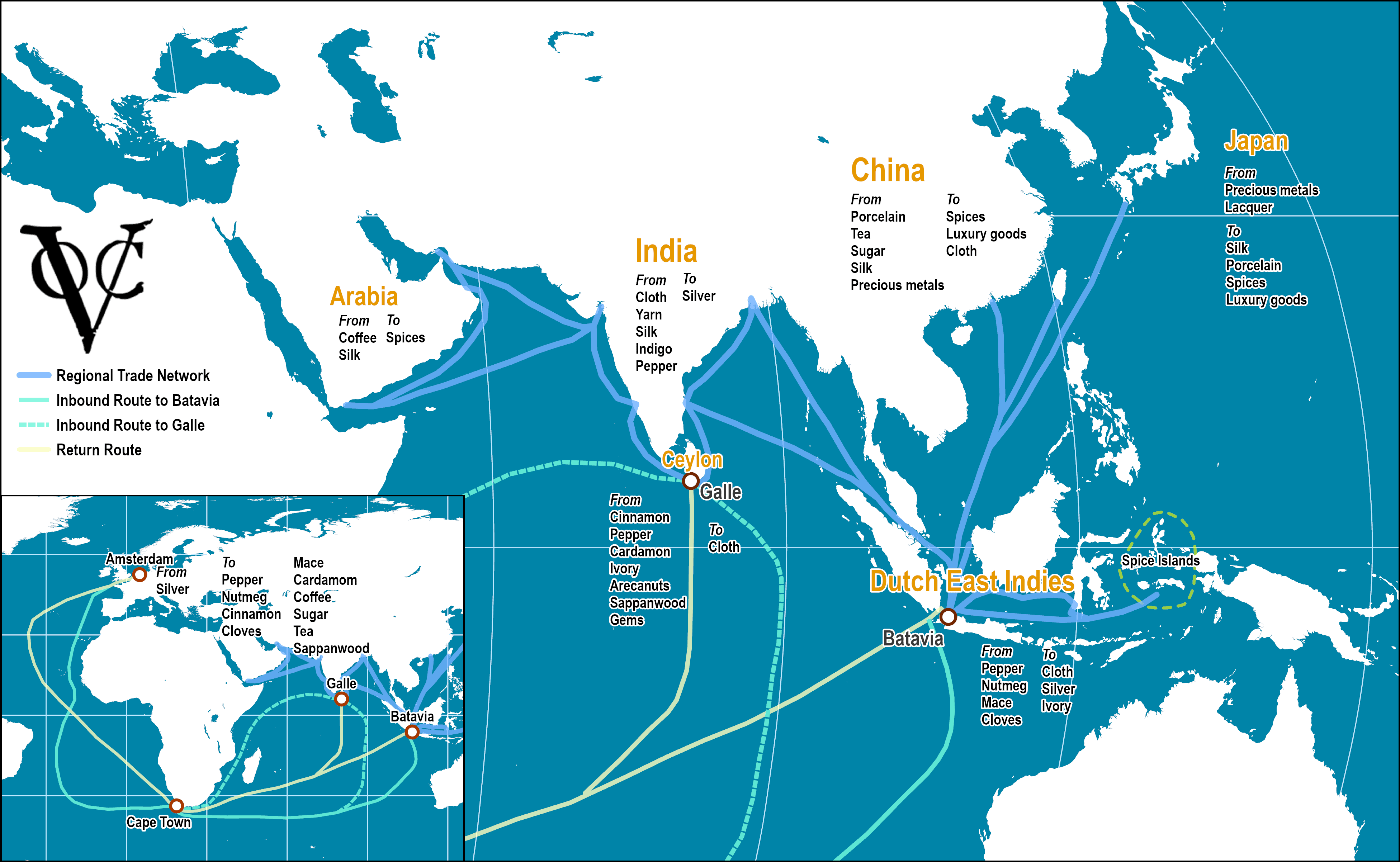
The Dutch East India Company
The Dutch East India Company
By a charter of the Government of Holland, the Dutch East India Company was established in 1602. As the Dutch were very much interested in spice trade, they had their focus on the Far East and made India their trading depot. In 1606, they established their factories at Peddapalli and Masulipatnam. Realizing that Indian textiles have a large market, they established factories at Pulicat in 1610, Cambay in 1620, Surat and Agra in 1621, Hariharapura in 1633, Patna in 1638, Dacca in 1650, Udaiganj in 1651, Chinsura in 1653, Quasim Bazar, Barangore, Balasore and Nagapattinam in 1659-60. The Dutch withdrew from Golconda by 1684. They also opened factories in Bengal, at Khanakul in 1669 and at Malda in 1676 but both were closed down soon.
The rising Dutch power was looked as a threat by the British and a truce was concluded between them in 1619 but it did not last long. By 1795, the British expelled the Dutch from India totally. The Dutch received encouragement from the rulers of Golkonda, the Nayaks of Tanjore and Shahjahan, Aurangzeb and Jahandar Shah.
Dutch Settlements:
After their arrival in India, the Dutch founded their first factory in masulipatnam in 1605. They went on to establish trading centres in different part of India and thus became a threat to Portuguese. They captured Nagapattinam near Madras from the Portuguese and made it their main stronghold in South India.
The Dutch established their factories on the coromandalcoast, in Gujarat, Uttar Pradesh, Bengal and Bihar. In 1609, they opened a factory in Pulicat, north of Madras. Their other principal factories in India were at Surat (1616), Bimlipatnam (1641), Karaikal (1645), Chinsurah (1653), Baranagar, kasimbazar (near Murshidabad), Balasore, Patna Nagapattinam (1658) and Cochin (1663).
The British East India Company
The English Association of the Merchant Adventurers’ was established in 1599 with the objective of carrying on trade with the east. This company, which is popular as east India Company obtained a Royal Charter with trade monopoly in the east from Queen Elizabeth on 31 December, 1600. In 1608, the first factory at Surat was decided to be established, but could not be established due to regional tension between Portuguese and English. Then, their first factory was established in Machilipatnam in 1611. By 1619, they established factories at Agra, Ahmedabad and Broach, one at Armagaon in 1625, and obtained Madras in 1639 and constructed Fort St. George. They acquired Bombay Island in 1668 and fortified it soon and it becomes the headquarters of the west in 1687.
In the east, they established their factories in Orissa at Hariharapura and Balasore in 1633, in 1651 at Hugli and in 1698 they acquired the Zamindari of Sumauti, Kalikata and Govindpur, where they built Fort William and in later days it grew into a big city known as Calcutta. The Company was empowered to make laws and judicial powers. In India, each factory was administered by a governor-in-council. There exists a close relationship between the company and the crown, and the crown and parliament controlled the East India Company through charters.
The English company’s position was improved by the ‘golden Farman’ issued to them by the sultan of Golconda in 1632. On a payment of 500 pagodas a year, the English were allowed to trade freely in the ports of Golconda. Further in 1639, they established a factory named St. George in Madras, and later replaced Masulipatnam as The Headquarter of the English settlement in South India.
At that time Bengal was a large and rich province in India, advanced in trade and commerce. Commercial and political control over Bengal naturally appeared in attractive proposition to the profit-seeking English merchant. Bengal was also an important province of the Mughal Empire.
Shah Shuja, the subedar of Bengal in 1651, allowed the English to trade in Bengal in return for an annual payment of Rs. 3000, in lieu of all duties. Factories in Bengal were started at Hooghly (1651) and other places like kasimbazar, Patna and Rajmahal. They captured fort of Thana, raided Hijli in East Midnapur and stormed Mughal fortification at Balasore.
In 1717, Mughal emperor Farukshiyar granted the British through a royal Farman (Magna Carta) some valuable trading facilities in Bengal. By this Farman the Company was permitted to export and import their goods in Bengal without paying taxes. It also authorized the Company to issue Dastaks (passes) for the transportation of such goods. Thus, we may observe that the English East India Company earned a number of trading concessions in Bengal from the Mughal authority by means of flattery and diplomacy.
By now, it has probably become clear that East India Company within a few decades of its arrival in this country has set a firm footing all over India. At the same time, the Company proceeded step by step in the path of transforming it from a trading corporation to a ruling power. The factors that helped the British to be the supreme power of India during the next two hundred years:
- The decline of the Mughal Empire after Aurangzeb resulted in the loss of central authority in India.
- The later Mughals were worthless rulers. They failed to control the activities of the foreigners like the British and the French in their own domain.
- The absence of political stability caused a sense of suspicion and insecurity among the Indian rulers. For their own security, they started to look for the assistance of the foreign power like the British.